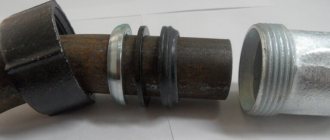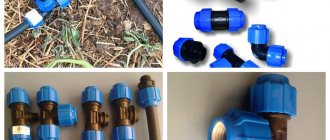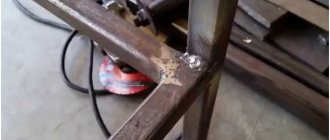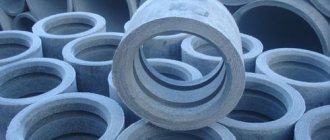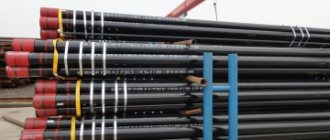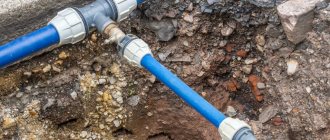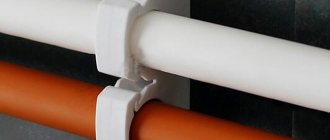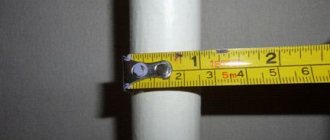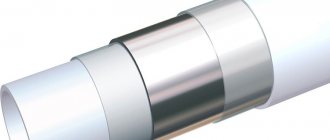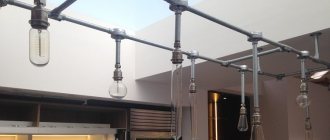Self-threaded pipe connections are often necessary not only in industrial conditions, but also at home - in an apartment or in the private sector. Usually, the connection of metal pipes without welding and threading in such conditions is carried out in a wide variety of unusual ways, materials and tools - whatever comes to hand. Such an attitude is fraught with poor quality results and can lead to an accident. Therefore, connecting profile pipes without welding with a predictably reliable result is flange and coupling methods.
Why is it sometimes preferable not to use either threaded connections or welding? There are the following reasons for this:
- A welding machine and welding work are quite expensive, and there is no reason to buy equipment and electrodes for a single joint of rolled metal;
- Welding is a complex electrical process, for the successful implementation of which certain conditions must be met: low humidity in the room, strategic space, professional skills, power supply in the room, etc.;
- The use of a welding machine is often stationary, and moving the welding site to the desired area is also not always possible.
Types of pipelines and welding
There are a huge number of pipelines that are used to move different materials and working fluids. Based on their purpose, there is the following classification:
- technological;
- main lines;
- industrial;
- gas supply pipelines;
- water;
- sewer.
In the manufacture of pipelines, various materials are used - ceramics, plastic, concrete and various types of metals.
Modern welders use three main methods for joining pipes:
- Mechanical is carried out due to explosions as a result of friction.
- Thermal, which is carried out by melting, for example by gas welding, plasma or electric beam.
- Thermo-mechanical is produced by a magnetically controlled arc using the butt contact method.
There are many types of welding, which are divided into many classifications. Before you weld pipes, you need to figure out what is the best way to do it. Theoretically, each type is suitable for welding pipes of small and large diameters. It can be carried out by melting and pressure. Melting methods include electric arc and gas welding, and pressure methods include gas press, cold, ultrasonic and contact. The most common methods for connecting communications are manual electric arc and mechanized.
Welding pipes using electric welding with consumable and non-consumable electrodes
It is most effective to weld technological pipelines with an electrode manually or using an automatic machine. This can be a method of working with a consumable or non-consumable electrode (argon-arc welding). Pipe welding technology is implemented in three main stages:
- Preparatory, which is divided into two parts - preparation of the master and preparation of the material. The preparation of a welder should be taken very seriously, since his safety depends on it. Be sure to prepare special clothing and a protective eye mask to prevent burns from bright sparks. By preparing parts we mean thoroughly cleaning pipes for welding from corrosion, paint and contaminants. Before manual arc welding of pipelines, you need to thoroughly treat the joints and the area adjacent to them with a metal brush or sandpaper. If this is not done, there may be “gaps” in the seam itself, since the material will not “get caught” on the contaminated pipe.
- Welding process. When everything is ready, you can start. The most important thing in the arc method (whether it is done manually or with an inverter) is to hold the arc. First you need to ignite the electrode and initiate the arc. Then the seam is fully completed. Its type is selected directly by the master during the work process. The method of guiding the electrode and the technology of pipeline welding in general is influenced by many factors - the location of the pipes, the material they are made of, and the preferences of the welder.
- Checking the quality of work. When the seam is ready (do not forget to beat off the slag that forms above it in the form of a roller), you can start communication to control the quality of the connection.
The technology for welding water pipes, gas pipelines and other utilities is almost the same. It is important to follow the sequence of actions and take into account the types of seams in different positions, since the quality of communication will depend on the ability to weld them.
How to join pipes
For a beginner who wants to master welding perfectly, it is necessary to know all the intricacies of this process. There are more than 30 methods for welding two pipes. Let's look at the most common pipe welding methods:
- in the corner;
- in the Taurus (perpendicular to each other);
- into the joint;
- overlap
The type of pipe joining is selected depending on the type of metal, type of welding and nature of communication. For example, pipes for a central heating system are most often connected end-to-end using electric welding. For a high-quality seam, the main thing is to make penetration throughout the entire thickness of the product.
A major role in the technique of welding pipes using manual arc welding is played by seam types, which are classified into four main groups:
Each of these methods has its own implementation technology. The most convenient and easiest way to make a quality connection is the bottom position. If it is possible to move and rotate the element, then the master tries to install them in the lower position. At the same time, during operation, the metal does not flow down, as with a vertical seam, and does not splash to the sides, as with a ceiling position. Welding of process pipelines is carried out using all these types, since communications have many branches.
Based on the type of seam duration on the pipeline, they are divided into continuous and intermittent seams.
Methods for connecting cast iron pipes
Cast iron pipes are traditionally used for the installation of non-pressure sewerage pipelines. As a rule, in this case, a permanent socket connection is used. To seal the joint, flax hemp or a similar material is used, which is poured either with liquid cement mortar or filled with silicone sealant.
Advice! Since pipes made of cast iron and steel are produced in the same sizes, the connection of cast iron and steel pipes is made using the same technology as the joining of two cast iron pipes.
Such connections are strong and, at the same time, elastic, so the assembled pipelines last for decades. When making a connection, the smooth end of the pipe is inserted into the other socket so that the annular gap between them is equal around the perimeter.
Advice! Not long ago, a technology was developed for connecting cast iron pipes into a socket with the installation of rubber seals. The use of this technology allows installation to be carried out much faster.
When installing fittings in a cast iron pipeline, flange connections are used. It should be noted that today cast iron is used much less frequently than before. When carrying out repair work, in most cases, old cast iron pipes are replaced with plastic ones.
If the pipeline is only partially changed, then the question arises, how should the connection be made between cast iron pipes and plastic pipes? To solve this problem, it is convenient to use special press fittings sealing the joint with tow or Teflon tape.
Features of pipe welding
Manual arc welding of pipelines differs significantly from working with flat parts. The same applies to other types that are used for water or gas pipelines (argon, gas). The following are the most basic aspects of welding pipes using manual arc welding:
- Device setting modes:
- The welding current is calculated as follows: the diameter of the electrode must be multiplied by 35. This will be the optimal force. For example, when working with a 3 mm conductor, the current will be (3x35) 105A. Of course, this figure is arbitrary, but on average this is what happens. When welding pipes of small diameter and thickness no more than 4 mm, more than 150 Atne will be required;
- in order to hold the arc, it is necessary to strictly maintain the distance between the conductor and the metals. It is calculated based on the diameter of the electrode +1. For example, with an electrode of 4 mm, the arc distance will be 5 mm.
- Welding small diameter pipes (up to 10 cm):
- Initially, the joints are assembled manually and tacked using the point method (two points located opposite each other are enough);
- when joining parts with a thickness of 4 mm or more, weld in two layers - first with the root seam, and then with a roller;
- horizontal seam when welding small-diameter pipes, each bead is laid in the opposite direction. For example, the first is from right to left, the second is from left to right, the third is from right to left, and so on;
- parts with a thickness of 3 to 8 centimeters need to be welded in small sections to obtain a better connection.
- Rotary joints and welding of large diameter pipes:
- the speed of rotation of the product should be equal to the speed of the conductor (it is set based on the thickness of the product (thicker ones take a little longer to weld);
- the most favorable position of the weld pool is 30 degrees from the top point;
- When welding in areas where it is possible to rotate the product 180 degrees, the work is carried out in three stages. The first is to weld the two upper quarters of the pipe diameter in two steps towards each other in one or two layers. The second is to turn the product and weld the remaining joint. Third - again turn 180 degrees and weld the seam to the end.
- Fixed joints are much more difficult to weld, so there is a certain technology for welding pipes using manual arc welding:
- vertical joints are welded in two stages. The perimeter of the joint is conventionally divided by a vertical straight line into two sections. They both have three positions: ceiling, horizontal and bottom. The ceiling is the area that occupies approximately 20 degrees from the lowest point of the part. Bottom – 20 degrees from the top point of the product. In between these positions is the horizontal position. Work must begin from the ceiling position and move the electrode in the lower position. Each section is processed with short arcs, which are calculated as follows: D(el)/2.
- horizontal joints are fastened at an angle back. The electrode should be positioned 80 degrees relative to the axis. The work is carried out on a medium arc and for welding pipes of small and large diameters.
By following these rules when welding water pipes using electric welding, you will get an even and beautiful seam, and most importantly, sealed, strong and durable.
Finally, it is important to note that arc pipe welding is widely used to work with different types of wires. We looked at how to properly cook parts in different positions. This is the peculiarity of processing these elements, since they are connected by different types of seams in different positions.
Beginners who have already become familiar with different types of connections will not find it difficult to adapt to welding pipes using manual arc welding. And don’t forget that half the success depends on the quality of stripping pipes for welding.
Pipeline welding technology is perfectly shown in the following video:
Source: svarkaed.ru
.. | Connection of metal pipes,
Connection of metal pipes having different diameters or shapes. How to connect pipes
.
Water and gas pipes
and electric welded pipes are used for gas supply, heating distribution, sewerage installations, and the manufacture of various structures in mechanical engineering, aircraft manufacturing, and agriculture. In this case, it is necessary to connect two or more pipes to each other.
The advantages of using steel pipes are that the pipes are easily bent and welded with gas, the structure is sealed and the work takes little time, the structure lasts for at least 20 years and does not need frequent repairs. However, metal pipes are subject to corrosion and are heavy. There are galvanized metal pipes, as well as pipes coated with polyethylene or epoxy applied to them. When burying pipelines in the ground, use a bitumen coating on the pipes.
Today, the following options for connecting steel pipes
:
joining steel pipes by welding,
connecting pipes using fittings,
joining pipes using flanges.
Welding of steel pipes
Depending on the required quality and the material used, metal pipes can be welded with: electrodes using an electric arc, gas welding machines, MIG/MAG (consumable electrode in a gas) and TIG (non-consumable electrode in a gas, most often argon) machines ).
Before welding, the edges of the pipes must be cleaned of rust and oxides and chamfered. The welding seam is filled with molten metal, resulting in a smoother and more airtight seam. When welding gas pipes
end-to-end, the seam should be convex and even along its entire length.
When welding with a gas torch, the end of the seam occurs with a slight voltage to prevent lack of penetration. A gas burner with two nipples is used. An oxygen cylinder is connected to one nipple, and a flammable gas cylinder or gas generator is connected to the second. Oxygen is mixed with flammable gas in the burner, forming a flame at the exit of the nozzle that heats the pipes. Gas welding of steel pipes
used mainly for pipes with a wall thickness of no more than 4 mm, since there is a risk of overheating the seam area, which makes it less durable.
Welding of steel water pipes
or
electric welded pipes
, ferrous metal or galvanized steel pipes are produced using a semi-automatic machine or manual arc welding is used.
This welding is applicable for pipes with a small diameter and thin walls, 1.5 - 5 mm thick. For welding water pipes, arc welding is most often used, as well as automatic or semi-automatic. Hot rolled steel sheets are used. Arc welding is also used to connect profile black and stainless pipes. When welding a profile pipe
with a thickness of 0.8 mm, the joint is welded with a short arc, with a thickness of 0.8 - 3.0 mm - with conventional arc welding, more than 3 mm - arc welding with gas-consumable electrodes is used.
When welding a profile pipe,
the root of the pipe seam is welded, but the metal itself should not be burned.
Before arc welding heating pipes
the ends are cleaned, chamfered, the pipes are centered together, grabbing at 3-4 points along the entire circumference of the pipe, then the seam is welded, filling the chamfer with welding material to 2/3 of the chamfer height.
First, use a smaller electrode with a diameter of 3 mm, then - if higher quality is needed - a second seam with an electrode of a larger diameter is placed on top. The joint surface is cleaned and any remaining slag is removed. When manually welding heating
using a semi-automatic machine, a mixture of gases is used, which consists of argon, carbon dioxide, oxygen.
When welding this way, the diameter of the welding wire must match the pipe. Typically, wire with a diameter of 1 - 1.2 mm is used to weld pipes with a wall thickness of up to 5 mm. There should not be much time between removing the electrode and connecting the surface, because this threatens to harden the surface and deteriorate the quality of the seam. If in a design one pipe is larger in diameter than the other, then such pipes are connected using flanges - special flat rings with holes for studs and bolts. Steel flanges
are widely used for pipeline transport and public utilities.
Flange connections
consist of flanges, gaskets, and fasteners. Depending on the parameters, flange structures are divided into solid and free. Solid ones undergo the same loads along with the body. Solid flanges are distinguished:
1)
cast - produced as one piece with the body,
2)
steel, which have a thread on the neck, is used for pipelines with low pressure,
3)
collar - a product welded end to end,
4)
flat steel welded flanges
- for process pipelines.
Loose flanges, in turn, are divided into:
flanges with collar (used in aggressive environments),
flanges on flanged pipe,
flanges on a welded ring (for pipelines made of non-ferrous metals and stainless steel).
Steel fittings
- the connecting part of the pipeline, which is used for turns and branches, transition to another pipe diameter. This connection ensures the tightness of the pipeline overlap. Fittings that connect the ends of pipes with the same diameter are called straight, those with different diameters are called transition fittings. They are threaded, welded, crimped and flanged.
Pipe fittings are divided into:
steel bends, pipe corners
(for turning the pipeline by 45, 90, 120 degrees),
connecting couplings - designed for connecting identical pipes in a straight section,
tees and manifolds - connecting pipes without welding
in one direction from the main pipe. In apartments, with a tee pipeline layout, pipes are led from a common riser to places of water consumption; with a collector circuit, pipes are led to each point of water consumption.
crosspieces - in two directions from the main pipe,
pipe adapters - for connecting pipes of different sections and types (for example, polypropylene and metal), has 2 - 4 holes. Using adapters, you can connect round and square pipes; for greater tightness, you need to choose adapters that have the most suitable dimensions.
plugs, caps, plugs - hermetically sealing the ends of pipes,
fittings - for connection with a flexible hose.
Fittings for steel pipes are produced with a nominal diameter (Dy) of 8 - 100 mm.
To join pipes of different diameters, they also use fittings - adapters (they look like bushings or nuts), which have internal and external threads, and the external thread has a larger diameter than the internal one.
Made of metal
When installing steel internal water supply pipes, small-diameter pipes with a thin wall are used. Welding of thin-walled steel pipes is carried out using a gas torch or an electric arc.
When inserting the internal comb of an apartment into the riser, a T-shaped connection is used. A hole is made in a pipe with a larger cross-section, and the thin walls of the second pipe are slightly ground off with a grinder for better joining.
There is no cutting of edges with this option. Before welding begins, the parts are cleaned of rust and dirt and joined together. Here it is important to ensure the correct location of the joints. They must be perpendicular or at a certain angle.
When working in procurement shops, as a rule, semi-automatic welding is used. At construction sites, preference is given to gas welding.
After proper joining, tack welding is required to secure the connection. On a small cross-section, 2 tacks are enough; as the diameter increases, the number of tacks increases.
For a non-rotating joint, the ceiling is first welded, then a vertical seam is made and welded in the lower position. This type of work requires the involvement of a qualified specialist.
Pipes of different diameters can be connected through metal adapters or inserted into one another.
If metal pipes of different diameters are inserted into one another, then you can make cuts in the larger pipe, bend the edges, and then weld.
Fittings are usually used for threaded connections of steel workpieces. Welding of registers, welding of barrels to a pipeline when moving gas equipment - this is an incomplete list where it may be necessary to weld pipelines of different sections.
Made from polypropylene
In modern construction and plumbing, it is customary to use various types of plastic pipes.
Pipes of different diameters made from these materials are connected using compression fittings or using “cold” welding. But these operations cannot be done without thermal welding.
Polypropylene pipelines are mainly used for laying indoor plumbing networks. Before starting welding, you need to prepare tools and materials for work. The choice of tools depends on the technology used. It could be:
- socket polyfusion welding;
- the use of adapters or couplings with heating elements located in them.
How to connect pipes
Before connecting metal pipes without welding, you should decide not only on the technology, but also, first of all, find out what material the products are made of. They can be flexible (polyethylene, polypropylene, metal-plastic) and rigid - cast iron, steel, products made of non-ferrous metals or PVC materials. It is more reliable to buy fittings, couplings, and flanges from the same manufacturer as the brand of the product.
Connections of plastic elements with metal products without threads and welding are easily carried out using flanges.
The advantage of such fastening is easy and quick dismantling for repairs and maintenance of utilities. For detachable elements of the line, flanges are also connecting elements. Lightweight water pipelines with a main diameter of ≤ 300 mm, and heavy and medium-weight elements with a diameter of ≤ 150 mm can be connected to each other using loose flanges with a direct support collar. These types of flanges are most often found in individual and industrial construction when assembling utility lines.
The first option is to connect steel or plastic products without threading or welding, using couplings. Couplings are made of high-strength materials, have special fasteners, and can fasten structural elements made of any materials and any diameter.
The second option for connecting a metal pipe or plastic product without threads and welding is flanges with a rubber or silicone gasket.
This threadless fastener is considered flexible, and the sequence of operations will be as follows:
- The ends of the products are cut at an angle of 900; it is not necessary to chamfer the ends;
- A flange is put on the end of the metal or polypropylene elements;
- A rubber gasket is inserted into the flange so that it protrudes 8-10 cm beyond the end;
- Next, the flange is connected to the connected part of the second element.
Some technical points that will help connect two pipes of the same diameter even from different materials, for example, fastening a plastic pipe to a metal one:
- In order not to disrupt or reduce the tightness of the joint, it is recommended to insert no more than one gasket into the connection of steel pipes;
- The tightness will be enhanced if rag cardboard soaked in drying oil is used as a gasket for water pipes;
- Threadless connection of heating pipes will be more reliable if the gasket is made of asbestos cardboard;
- The outer diameter of the gasket should not protrude beyond the edges of the pipe by more than 1-1.5 cm, and the internal diameter of the gasket should be greater than the diameter of the pipe being connected.
Option three - connecting steel products without welding on the coupling. This mount is a type of compression fitting. The Gebo coupling makes the process of threadless connection of steel products faster and more reliable, and no special tools are needed to work with this fastener.
Installation of the Gebo coupling for connection without threading and welding is carried out in the following sequence:
- The coupling nut is put on the pipe;
- After the nut, put on the clamping ring, followed by the clamping and sealing ring;
- Next, a coupling is put on up to half the length of the product, the nut is tightened;
- The second half of the fastener is assembled and connected to the fitting in the same way.
The fourth option for connecting 2 pipes without threading or welding is to use an installation and repair clip. This is a kind of fitting that looks like a coupling or tee, but the cage consists of two halves, and both halves are connected to each other with a bolt fastening.
Such methods of joining are rather temporary in nature, so the assembly and repair clip must subsequently be dismantled and the elements connected more firmly. But in emergency situations, the clip connection can also be used as a connection for two pipes. The process looks like this:
- The section of the metal pipe is cleaned and polished almost to a mirror surface. This is one of the disadvantages of connecting to a clip. Using an installation and repair clip, you can also connect pipelines made of aluminum: it is easier to work with aluminum products, since they are not covered with rust and are cleaned faster;
- A rubber seal is put on the cleaned area and lubricated with sealing paste;
- Both halves of the fitting are put on the seal and tightened with a bolt.
The option with a repair and installation clip does not look complicated or expensive, but the time costs are due to the lengthy cleaning of the areas being connected. In addition, instead of a clip, you can use a regular clamp, which is bolted together not on both sides, like a clip, but only on one side. Screeding with a clamp will not require thorough cleaning of the surface, since a porous gasket is placed under the damaged area. Fastening with a clamp will be even more reliable than threaded connections or welding.
Made from polyethylene
Welding large-diameter polyethylene pipes requires slightly different work. Large cross-section pipes are welded using the butt method.
To do this, you will need to use a welding machine, a reliable pipe cutter, solvent and rags. A welding machine is a multifunctional unit, which includes a part-centering mechanism, a trimmer, a heater, and a hydraulic station that provides sufficient force when joining heated parts end-to-end.
The equipment runs on electricity. If there are no power supplies nearby, you should prepare a diesel or gasoline generator.
HDPE pipes must be welded in the following order:
- a pipe blank is made according to a sketch or project;
- the parts to be welded are fixed using the machine’s centralizer;
- the ends of the workpiece are treated to remove dirt and oil;
- the trimmer trims edges for welding and cleans parts from chips;
- a heated plate is placed between the ends of the pipes, the ends are pressed firmly against its surface;
- when the ends heat up to melting, the plate is removed, and the workpieces are joined end-to-end;
- Using hydraulics, a certain force is maintained until the joint cools.
In the same way, you can connect HDPE pipes of different diameters. The quality of the connection is affected by the selected heating temperature, the force required to connect the heated parts and the time required to complete all welding cycles.
In case of thick wall
Welding thick-walled pipes will require an increase in all parameters. The temperature should be between 2000 - 2300, the force is controlled using a pressure gauge.
But the best way to monitor the condition of the seam beads is visual inspection. If the rollers are thin, it means that the heating temperature was not high enough. This is an unreliable connection and should be digested.
To connect sections with different diameters, adapters made of the same materials as the pipe itself are used. Welding parts of different diameters through an adapter is performed in exactly the same way, as is a connection of the same diameter.
The electrofusion method is most often used for welding plastic parts. It is especially often used when welding HDPE workpieces of small diameter.
The pipes are placed in special fittings with heating elements located in them. The coupling material, when melted, reliably welds workpieces of different diameters.
When performing work, it is necessary to firmly fix the workpieces. Heating is carried out automatically; after welding is completed, all that remains is to disconnect the contacts.
In conclusion, it must be recalled that no matter how welding of pipes of different diameters is carried out, fire and electrical safety rules must be followed.
Source: svaring.com
Methods for connecting asbestos-cement pipes
Asbestos-cement pipes are made from Portland cement and asbestos fiber mixed in a ratio of 4 to 1. The pipes are produced in different sizes and are used for installing pipelines for transporting various media. What connection of asbestos-cement pipes should be used? The answer to this question depends on what operating pressure the pipeline is designed for.
So, if the operating pressure in the pipeline is planned to be low (up to 3 kgf/cm³), then the connection of asbestos-cement pipes is made using asbestos-cement couplings with rubber seals. To install the coupling, use a special jack.
If a pressure pipeline is installed, the operating pressure in which will be from 6 kgf/cm³, the connection of asbestos pipes is carried out using special fittings - Gibot couplings. The tightness of this connection is ensured by the presence of rubber rings that are installed between the flanges and the cast iron bushing.
So, in the construction of pipelines, various types of pipe connections are used, including the connection of metal pipes without welding. In addition, special connection technologies are used when installing various measuring instruments and devices on the pipeline. For example, for this purpose, a ball joint of pipes can be used, characterized by the presence of a spherical nipple in the connected flange.
